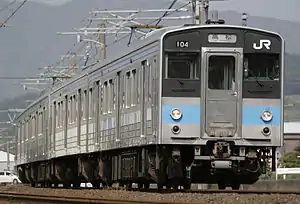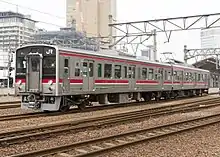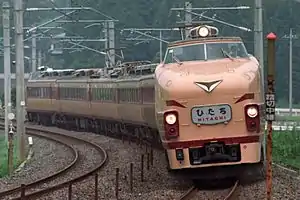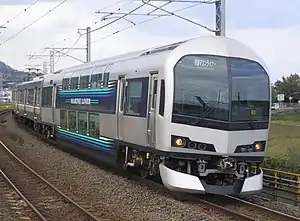121 series
The 121 series (121系) is an electric multiple unit (EMU) train type introduced in March 1987 by Japanese National Railways (JNR), and currently operated by Shikoku Railway Company (JR Shikoku) on local services in Shikoku, Japan.[1][2]
| 121 series 7200 series | |
|---|---|
 A pair of 121 series sets on the Yosan Line in May 2009 | |
| In service | March 1987 |
| Manufacturer | Hitachi, Kawasaki Heavy Industries, Kinki Sharyo, Tokyu Car Corporation |
| Constructed | 1986–1987 |
| Refurbished | 2016–2019 |
| Number built | 38 vehicles (19 sets) |
| Number in service | 38 vehicles (19 sets) |
| Formation | 2 cars per trainset |
| Operator(s) | JNR (1987) JR Shikoku (1987–) |
| Depot(s) | Takamatsu |
| Line(s) served | Dosan Line, Yosan Line |
| Specifications | |
| Car body construction | Stainless steel |
| Car length | 20,000 mm (65 ft 7 in) |
| Width | 2,800 mm (9 ft 2 in) |
| Height | 3,670 mm (12 ft 0 in) |
| Floor height | 1,180 mm (3 ft 10 in) |
| Doors | 3 pairs per side |
| Maximum speed | 100 km/h (60 mph) |
| Traction system | 121 series: Resistor Control MT55A traction motors (from 103 series) 7200 series: Toyo S-CS63A IGBT-VFD S-MT64 traction motors |
| Power output | 121 series: 110 kW x 4 7200 series: 140 kW x 4 |
| Acceleration | 2 km/h/s |
| Electric system(s) | 1,500 V DC overhead |
| Current collection method | Overhead catenary |
| Bogies | 121 series: DT33A (motored) DT12T (trailer) 7200 series: S-DT67ef (motored) S-TR67ef (trailer) |
| Multiple working | 7200 series: 7000 series |
| Track gauge | 1,067 mm (3 ft 6 in) |
Design
The 121 series design is based on the earlier 105 series, with lightweight stainless steel bodies.[3]
The motor bogies were the same DT33A bogies as used on the JNR-era 103 series EMUs, and the trailer cars used DT21T bogies recovered from withdrawn 101 series EMUs.[4] The pantographs were also recovered from withdrawn 101 series EMUs.[4]
 A DT21T trailer bogie
A DT21T trailer bogie
Operations
The sets are based at Takamatsu Depot and operate on the Yosan Line and Dosan Line in 2-, 4-, or 6-car formations.[2][5]
Formations
As of 1 April 2016, the fleet consists of 18 two-car 121 series sets and one 7200 series formed of one motored "Mc" car and one non-powered "Tc" trailer car as shown below with the motored "Mc" cars at the Takamatsu end.[5]
121 series
| Designation | Mc | Tc |
|---|---|---|
| Numbering | KuMoHa 121 | KuHa 120 |
| Weight (t) | 42.0 | 28.0 |
| Capacity (total/seated) | 118/62 | 118/62 |
The "Mc" cars are each fitted with one S-PS58 lozenge-type pantograph.[5]
 KuMoHa 121-14 in December 2007
KuMoHa 121-14 in December 2007 KuHa 120-14 in December 2007
KuHa 120-14 in December 2007
7200 series
| Designation | Mc | Tc |
|---|---|---|
| Numbering | KuMoHa 7200 | KuHa 7300 |
| Weight (t) | 37.6 | 28.5 |
| Capacity (total/seated) | 132/52 | 132/52 |
The "Mc" cars are each fitted with one S-PS58 lozenge-type pantograph.[6]
 7218 in January 2019
7218 in January 2019 7318 in January 2019
7318 in January 2019
Interiors
Seating is arranged as a mix of transverse seating bays and longitudinal bench seats.[2] The sets are not equipped with toilets.[5]
 An interior view in September 2007
An interior view in September 2007
History
The 121 series sets were introduced on 23 March 1987, just nine days before JNR was privatized on 1 April, following which the 121 series fleet came under control of JR Shikoku.[4] The sets were originally delivered with magenta "Red No. 20" bodyside stripes, but were repainted with JR Shikoku corporate light blue ("Blue No. 26") bodyside stripes during September and October 1987.[2]
In 1992, the original pantographs were replaced with the same S-PS58 type pantographs also used on the JR Shikoku 7000 series EMUs to ensure adequate clearance through tunnels on newly electrified sections of the Yosan Line.[4]
In 2011, two sets (numbers 001 and 002) were modified for wanman driver only operation. These sets were repainted with their original JNR-style magenta bodyside stripes.[5]
 121 series sets in original JNR livery, circa 1987
121 series sets in original JNR livery, circa 1987 Set 009 with a front-end red warning stripe added for a short period during the 1990s
Set 009 with a front-end red warning stripe added for a short period during the 1990s A pair of 121 series sets in May 2009
A pair of 121 series sets in May 2009 Modified driver-only set 001 in April 2012
Modified driver-only set 001 in April 2012
Refurbishment and conversion

From 2016, the entire fleet of 19 two-car trainsets is scheduled to undergo refurbishment, and at the same time reclassified "7200 series". Refurbishment includes replacement of the DC motors with 140 kW AC motors and VVVF control, new side windows, new "efWing" CFRP bogies (S-DT67ef motor bogies and S-TR67ef trailer bogies), and a new livery based on the original style with a thin green line added to the magenta bodyside stripe.[6] Internally, the refurbished trains have fixed four-person seating bays on one side with longitudinal bench seating on the other.[6]
The first trainset to be treated, set 3, was outshopped from JR Shikoku's Tadotsu Works in February 2016,[7] and entered service from 13 June 2016.[8]
 An S-DT67ef motor bogie on car KuMoHa 7203
An S-DT67ef motor bogie on car KuMoHa 7203 An S-TR67ef trailer bogie on car KuHa 7303
An S-TR67ef trailer bogie on car KuHa 7303 7200 series sets R04+R03 in October 2016
7200 series sets R04+R03 in October 2016
Fleet history
The individual build histories for the fleet are as follows.[4]
| Set No. | Manufacturer | Date delivered | 7200 series conversion date |
|---|---|---|---|
| 001 | Hitachi | 17 November 1986 | 12 October 2018 |
| 002 | Kinki Sharyo | 20 November 1986 | 18 February 2019 |
| 003 | Kawasaki Heavy Industries | 13 December 1986 | 15 March 2016 |
| 004 | Kawasaki Heavy Industries | 13 December 1986 | 9 September 2016 |
| 005 | Kinki Sharyo | 27 December 1986 | 28 March 2017 |
| 006 | Kinki Sharyo | 27 December 1986 | 20 February 2018 |
| 007 | Kinki Sharyo | 27 December 1986 | 7 November 2017 |
| 008 | Tokyu Car | 27 January 1987 | 5 June 2017 |
| 009 | Tokyu Car | 27 January 1987 | 28 February 2017 |
| 010 | Tokyu Car | 27 January 1987 | 22 August 2018 |
| 011 | Tokyu Car | 27 January 1987 | 28 December 2017 |
| 012 | Hitachi | 13 January 1987 | 2 July 2018 |
| 013 | Hitachi | 27 January 1987 | 28 October 2016 |
| 014 | Hitachi | 27 January 1987 | 6 December 2016 |
| 015 | Kawasaki Heavy Industries | 16 January 1987 | 13 September 2017 |
| 016 | Kawasaki Heavy Industries | 16 January 1987 | 18 January 2017 |
| 017 | Kawasaki Heavy Industries | 16 January 1987 | 20 July 2017 |
| 018 | Kinki Sharyo | 20 January 1987 | 11 December 2018 |
| 019 | Kinki Sharyo | 20 January 1987 | 28 March 2018 |
References
| Wikimedia Commons has media related to 121 series. |
- Haraguchi, Takayuki (2009). Jr全車両: ビジュアル決定版 Encyclopedia of JR's Railway Cars: JR全車輌. Japan: Sekai Bunka. p. 75. ISBN 978-4-418-09905-4.
- Jēāru zensharyō handobukku: Rail Magazine 2009 JR全車輌ハンドブック2009 [JR Rolling Stock Handbook 2009]. Japan: Neko Publishing. 2009. p. 256. ISBN 978-4-7770-0836-0.
- Fukuhara, Shunichi (August 2016). 121系近郊形直流電車のあゆみ part1 [The history of the 121 series suburban DC EMU trains (part 1)]. Japan Railfan Magazine (in Japanese). Vol. 56 no. 664. Japan: Koyusha Co., Ltd. p. 84–87.
- Fukuhara, Shunichi (September 2016). 121系近郊形直流電車のあゆみ part2 [The history of the 121 series suburban DC EMU trains (part 2)]. Japan Railfan Magazine (in Japanese). Vol. 56 no. 665. Japan: Koyusha Co., Ltd. p. 94–99.
- Jr電車編成表 JR電車編成表 2016夏 [JR EMU Formations - Summer 2016] (in Japanese). Japan: Kotsu Shimbunsha. 20 May 2016. p. 205. ISBN 978-4-330-68216-7.
- Yoshimoto, Eizaburo (August 2016). 7200系近郊形直流電車 [7200 series suburban DC EMU trains]. Japan Railfan Magazine (in Japanese). Vol. 56 no. 664. Japan: Koyusha Co., Ltd. p. 84–87.
- JR四国121系第3編成が7200系となり出場 [JR Shikoku 121 series set 3 outshopped as 7200 series]. Japan Railfan Magazine Online (in Japanese). Japan: Koyusha Co., Ltd. 3 February 2016. Retrieved 12 May 2016.
- JR四国7200系が営業運転を開始 [JR Shikoku 7200 series enters revenue service]. Japan Railfan Magazine Online (in Japanese). Japan: Koyusha Co., Ltd. 14 June 2016. Retrieved 14 June 2016.

